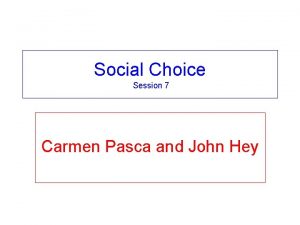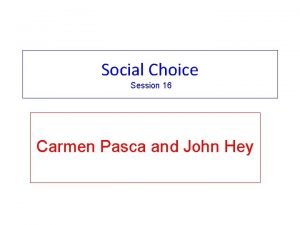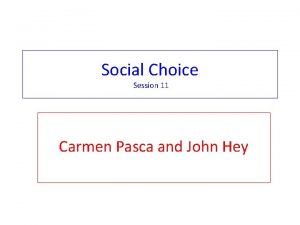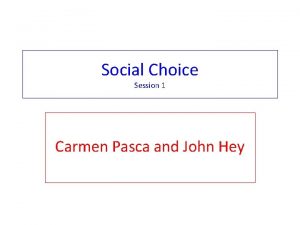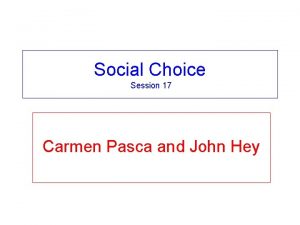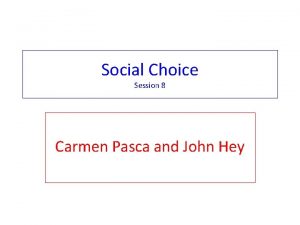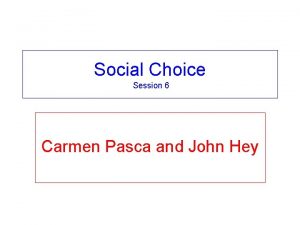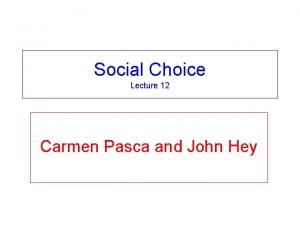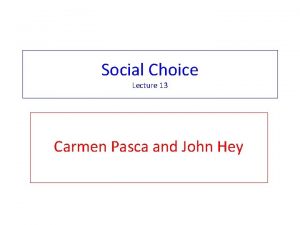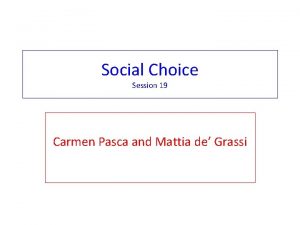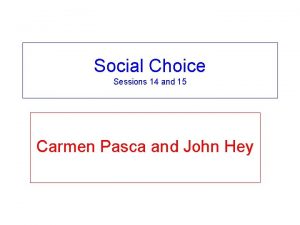Social Choice Session 3 Carmen Pasca and John





















- Slides: 21

Social Choice Session 3 Carmen Pasca and John Hey

Plan for this session • We start with a review of Arrow’s theorem – using now Jen’s preferences to give completeness and showing that this leads to her being the dictator. • Then, within the same framework (ordinal preferences) we explore how we may weaken Arrow’s assumptions and possibly get some possibility. • After a short break we will invite comments from you as to other ways to get possibility. • (Note: in session 6 we explore the implications of cardinality/measurability of preferences – so we do not do this today. )

Arrow’s Impossibility Theorem • In social choice theory, Arrow’s impossibility theorem. . . states that, when voters have three or more discrete alternatives (options), no voting system can convert the ranked preferences of individuals into a community-wide ranking while also meeting a certain set of criteria. These criteria are called unrestricted domain, non-dictatorship, Pareto efficiency, and independence of irrelevant alternatives. (Wikipedia) • We remind you of Arrow’s famous result and explore more its implications. • We again draw inspiration from John Bone at York and borrow some of his slides.

Arrow • Arrow’s conditions are these: • Universal Domain: is applicable to any profile. • Consistency: produces a complete, transitive ordering of available alternatives. • Pareto: if everyone prefers x to y then so should society. • Independence of Irrelevant Alternatives: orders x and y on the basis only of individual preferences on x and y. • Can we replace/eliminate/weaken any of these? • This is the question we address today.

Back to session 2 briefly • We go back to where we had to assume society’s preferences in order to get completeness. . . • . . . and we take an alternative way. • We go to slide number 12 of the Power. Point presentation of session 2. . . • . . . after which we once again shamelessly use John Bone’s thoughts and slides.

Can we plausibly relax Arrow’s conditions? Universal Domain: is applicable to any profile Perhaps there are some profiles at which we might not require a social ordering at all? Especially for profiles of (e. g. malicious) preferences. But perhaps also for profiles of welfare rankings. For example if x and y are different allocations of economic goods, and J is allocated more of every good under x than under y, then it might be reasonable to ignore any hypothetical profile in which J ranks y above x. Might this be enough to escape the problem?

Can we plausibly relax Arrow’s conditions? Pareto: if everyone prefers x to y then so should society Perhaps for similar reasons as with Universal Domain A Sen, “The impossibility of a Paretian Liberal”, Journal of Political Economy, vol 78 (1970), 152 -7 A single copy of Lady Chatterley’s Lover a: Ken (Prude) reads it b: Jen (Liberal) reads it c: neither reads it Jen Ken Pareto → abc cab Liberalism → Ignore “meddlesome” preferences? a. Pb b. Pc c. Pa (We will return to Sen shortly. )

Can we plausibly relax Arrow’s conditions? Independence of Irrelevant Alternatives Whatever determines the relative merits of x and y should not include individual welfare data regarding z …. . . but should instead be intrinsic to x and y. So at any two profiles in which the individual welfare data regarding (only) x and y is the same, the social ordering of x and y should also be the same. This becomes problematic when the individual welfare data comprises only rankings that is, comprises only ordinal welfare data

Can we plausibly relax Arrow’s conditions? Consistency: complete transitive ordering We may only have to decide which of the available alternatives should be (socially) chosen. So why require a complete, transitive social ordering of all available alternatives ? This is equivalent to requiring the social choice to be consistent across different (hypothetical) sets of alternatives Whatever determines the relative merits of x and y should not include the availability or otherwise of z …. . . but should instead be intrinsic to x and y.

A single copy of Lady Chatterley’s Lover a: Ken reads it Jen abc Ken cab b: Jen reads it choose: c: neither reads it a from {a, b} b from {b, c} c from {a, c} ? from {a, b, c} Whatever is the choice from {a, b, c}, there is inconsistency. But so what?

Majoritarianism Choose x from {x, y} iff more people prefer x to y than prefer y to x. Jen abc Ken cab Len bca choose: a from {a, b} b from {b, c} c from {a, c} ? from {a, b, c} Whatever is the choice from {a, b, c}, there is inconsistency. But so what?

Sen’s Impossibility of a Paretian Liberal • The idea is that each individual has the right to determine things ‘locally’ – that is, those things that concern only him or her. So individuals are decisive over local issues. • For example, I should be free to choose whether or not I read Lady Chatterley’s Lover. • He gives a nice example, which we have already seen. Three alternatives, a, b and c, and two people A and B. • a: Mr A (the prude) reads the book; • b: Mr B (the lascivious/liberal) reads the book; • c: Neither reads the book.

Lady C. • Mr A (the Prude): c > a > b • Mr B (the Lascivious): a > b > c • Now assume that Mr A is decisive over (a, c) and that Mr B is decisive over (b, c). • So from A’s preferences c > a and from B’s preferences b > c. From unanimity a > b. • Hence we have b > c (B) and c > a (A) and a > b (unanimity)! • WEIRD! (Intransitive).

Sen’s Theorem • Condition U (Unrestricted domain): The domain of the collective choice rule includes all possible individual orderings. • Condition P( Weak Pareto): For any x, y in X, if every member of society strictly prefers x to y, then x. Py. • Condition L* (Liberalism): For each individual i, there is at least one pair of personal alternatives (x, y) in X such that individual i is decisive both ways in the social choice process. • Theorem: There is no social decision function that satisfies conditions U, P and L*.

Proof • P indicates Society’s preference and Pi that of individual i. • Suppose i is decisive over (x, y) and that j is decisive over (z, w). Assume that these two pairs have no element in common. • Let us suppose that x. Piy, z. Pjw, and, for both k=i, j that w. Pkx and y. Pkz. • From Condition L* we obtain x. Py and z. Pw. • From Condition P we obtain w. Px and y. Pz. • Hence it follows that • x. Py y. Pz z. Pw and w. Px. • Cyclical.

Gibbard’s Theory of Alienable Rights • Background. . . • Going back to the Lady C example, Mr A may realise that maintaining his right to decisiveness over (a, c) leads to an impasse/intransitivity. • He cannot get c (his preferred option) because Mr B has rights over that and renouncing his right to decisiveness over (a, c), society will end up with a (which is preferred by Mr A to b – his least preferred). • (Might Mr B think similarly (mutatis mutandis) and give up his right to decisiveness? )

Gibbard’s own example • Three persons: Angelina, Edwin and the ‘judge’. • Angelina prefers marrying Edwin but would marry the judge. • Edwin prefers to remain single, but would prefer to marry Angelina rather than see her marry the judge. • Judge is happy with whatever Angelina wants. • Three alternatives: • x: Edwin and Angelina get married • y: Angelina and the judge marry (Edwin stays single) • z: All three remain single • Angelina has preference: x PA y PA z • Edwin has preference: z PE x PE y

The problem and its solution Angelina has a libertarian claim over the pair (y, z). Edwin has a claim over (z, x). Edwin and Angelina are unanimous in preferring x to y. So we have a preference cycle: y. Pz, z. Px, x. Py. If Edwin exercises his right to remain single, then Angelina might end up married to the judge, which is Edwin’s least preferred option. • ‘Therefore’ it will be in Edwin’s own advantage to waive his right over (z, x) in favour of the Pareto preference x. Py. • • •

Gibbard’s Theory of Alienable Rights • Condition GL: Individuals have the right to waive their rights. • Gibbard’s rights-waiving solution: There exists a collective choice rule that satisfies conditions U, P and GL. • The central role of the waiver is to break a cycle whenever there is one. . . • . . . but the informational demands are high.

Now a short break • After the break we invite you to suggest other ways of breaking Arrow’s impossibility. . . • . . . within the ordinal preferences framework. • Note that we could dispense with the notion of trying to find society’s preferences. . . • . . . we could immediately think about a decision rule of society which depends upon individual preferences. . • . . . Like doing something if a majority of the population want to do it. • Problems with this? Intransitivity?

Conclusions • So what do we conclude from all of this? • Essentially that, whatever way we do the aggregation, there is no method, that does not have objections, to aggregate individual preferences into a set of social preferences. • Is this surprising? • What are its implications? • That we cannot leave a computer in charge of society. • We need decision-making bodies with flexibility and some autonomy but also somehow under the control of the members of society.
 Good choice or bad choice
Good choice or bad choice Aglaonema dikenal juga dengan nama
Aglaonema dikenal juga dengan nama Pasca spm
Pasca spm Pengertian pasca produksi
Pengertian pasca produksi Teori evolusi pasca darwin
Teori evolusi pasca darwin Penyelesaian audit dan tanggung jawab pasca audit
Penyelesaian audit dan tanggung jawab pasca audit Pasca panen telur
Pasca panen telur Penanganan pasca panen serealia
Penanganan pasca panen serealia Profilaksis pasca pajanan
Profilaksis pasca pajanan Ejaan pascamerdeka
Ejaan pascamerdeka Pasca perkhidmatan jpa
Pasca perkhidmatan jpa Fisiologi pasca panen adalah
Fisiologi pasca panen adalah Pasca panen lada
Pasca panen lada Pasca konstruksi adalah
Pasca konstruksi adalah Kata hubung terbahagi kepada
Kata hubung terbahagi kepada Uji pasca senggama
Uji pasca senggama Pembubaran voc
Pembubaran voc Pengertian pasca panen
Pengertian pasca panen Pengertian pasca panen
Pengertian pasca panen Manajemen pertunjukan musik adalah
Manajemen pertunjukan musik adalah Ipb ocw
Ipb ocw Peer coaching plc pdf
Peer coaching plc pdf






















